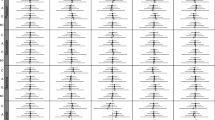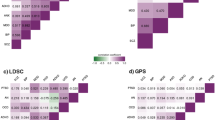Abstract
We extend the DeFries-Fulker regression model for the analysis of quantitative twin data to cover binary traits and genetic dominance. In the proposed logistic regression model, the cotwin's trait status,C, is the response variable, while the proband's trait status,P, is a predictor variable coded ask (affected) and 0 (unaffected). Additive genetic effects are modeled by the predictor variablePR, which equalsP for monozygotic (MZ) andP/2 for dizygotic (DZ) twins; and dominant genetic effects, byPD, which equalsP for MZ andP/4 for DZ twins. By setting an appropriate scale forP (i.e., the value ofk), the regression coefficients ofP, PR, andPD are estimates of the proportions of variance in liability due to common family environment, additive genetic effects, and dominant genetic effects, respectively, for a multifactorial liability-threshold model. This model was applied to data on lifetime depression from the Virginia Twin Registry and produced results similar to those from structural equation modeling.
Similar content being viewed by others
References
Agresti, A. (1984).Analysis of Ordinal Categorical Data, John Wiley & Sons, New York.
Bonney, G. E. (1986). Regressive logistic models for familial disease and other binary traits.Biometrics 42:611–625.
Browne, M. W. (1984). Asymptotically distribution-free methods for the analysis of covariance structures.Br. J. Math. Stat. Psychol. 37:62–83.
Cox, D. R. (1970),The Analysis of Binary Data, Methuen, London.
DeFries, J. C., and Fulker, D. W. (1985). Multiple regression analysis of twin data.Behav. Genet. 15:467–473.
Falconer, D. S. (1965). The inheritance of liability to certain diseases, estimated from the incidence among relatives.Ann. Hum. Genet. 29:51–76.
Fulker, D. W., Cardon, L. R., DeFries, J. C., Kimberling, W. J., Pennington, B. F., and Smith, S. D. (1991). Multiple regression analysis of sib-pair data on reading to detect quantitative trait loci.Read. Writ. 3:299–313.
Heath, A. C., Neale, M. C., Hewitt, L., Eaves, L. J., and Fulker, D. W. (1989). Testing structural equation models for twin data using LISREL.Behav. Genet. 19:9–35.
Hannah, M. C., Hopper, J. H., and Matthews, J. D. (1983). Twin concordance for a binary trait. 1. Statistical models illustrated with data on drinking status.Acta Genet. Med. Gemellol. 32:127–137.
Hannah, M. C., Hopper, J. H., and Matthews, J. D. (1985). Twin concordance for a binary trait. 2. Nested analysis of ever-smoking and ex-smoking traits and unnested analysis of a “committed-smoking” trait.Am. J. Hum. Genet. 37:153–165.
Jöreskog, K. G., and Sörbom, D. (1986).LISREL: Analysis of Linear Structural Relationships by the Method of Maximum Likelihood, National Educational Resources, Chicago.
Jöreskog, K. G., and Sörbom, D. (1988).PRELIS: A Program for Multivariate Data Screening and Data Summarization. A Preprocessor for LISREL, 2nd ed., Scientific Software, Mooresville, IN.
Kendler, K. S., Neale, M. C., Kessler, R. C., Health, A. C., and Eaves, L. J. (1992). A population-based twin study of major depression in women: The impact of varying definitions of illness.Arch. Gen. Psychiat. 49:257–266.
Liang, K. Y., and Beaty, T. H. (1991). Measuring familal aggregation by using odds ratio regression models.Genet. Epidemiol. 8:361–370.
Neale, M. C. (1991).Mx: Statistical Modelling, Department of Psychiatry, Box 710 MCV, Richmond, VA 23298.
Neale, M. C., and Cardon, L. R. (1992).Methodology for Genetic Studies of Twins and Families, Kluwer, Dordrecht.
Pearson, K. (1990). On the correlation of characters not quantitatively measurable.Roy. Soc. Philos. Trans. Ser. A 195:1–47.
Peduzzi, P. N., Detre, K. M., and Chan, Y. K. (1983). Upper and lower bounds for correlations in 2×2 tables—Revisited.J. Chron. Dis. 36:491–496.
Reich, T., James, J. W., and Morris, C. A. (1972). The use of multiple thresholds in determining the mode of inheritance of semi-continuous traits.Ann. Hum. Genet. 36:163–184.
Reich, T., Rice, J. P., Cloninger, C. R., Wette, R., and James, J. (1979). The use of multiple thresholds and segregation analysis in analyzing the phenotypic heterogeneity of multifactorial traits.Ann. Hum. Genet. 42:371–390.
Smith, C. (1974). Concordance in twins: Methods and interpretations.Am. J. Hum. Genet. 26:454–466.
Spitzer, R. L., William, J. B., and Gibbon, M. (1987). Structured Clinical Interview for DSM-IIIR, Biometrics Research Department and New York State Psychiatric Institute, New York.
Author information
Authors and Affiliations
Rights and permissions
About this article
Cite this article
Sham, P.C., Walters, E.E., Neale, M.C. et al. Logistic regression analysis of twin data: Estimation of parameters of the multifactorial liability-threshold model. Behav Genet 24, 229–238 (1994). https://doi.org/10.1007/BF01067190
Received:
Accepted:
Issue Date:
DOI: https://doi.org/10.1007/BF01067190




